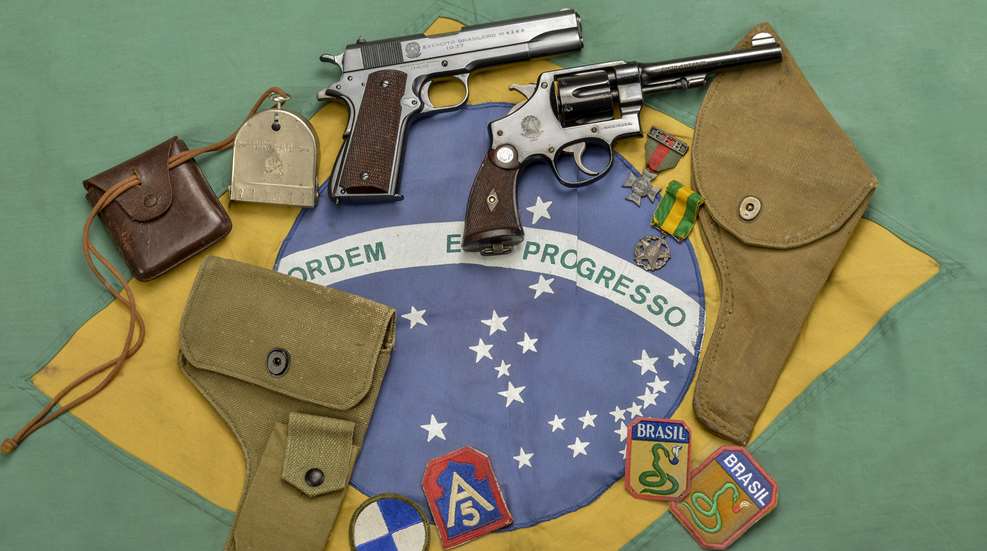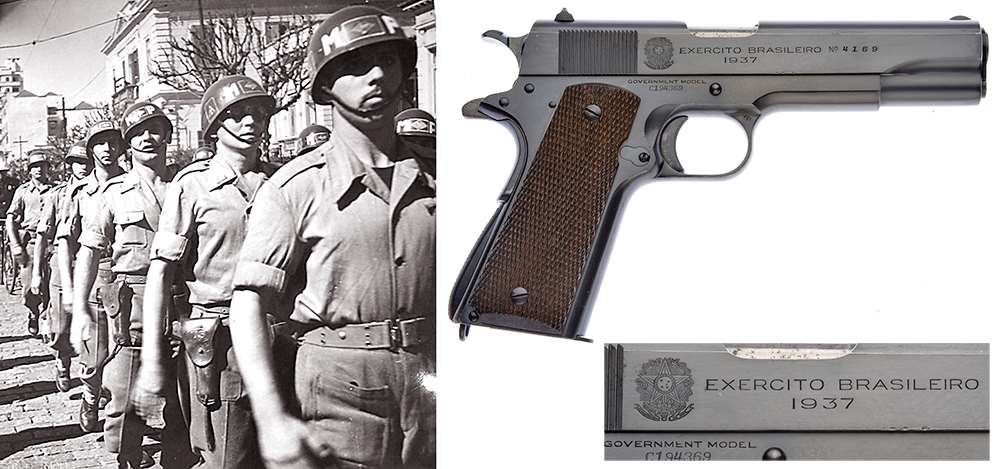
Mementos shown from the Brazilian Expeditionary Force (clockwise from upper l.): a Brazilian army compass; a Colt Government Model, Brazilian 1937 contract; a Smith & Wesson Hand Ejector Model 1917, Brazilian 1937 contract; an Italian Theater “Campaign Medal;” a Brazilian army Long Service Medal; an FEB canvas holster for the S&W Model 1917; metal and cloth FEB shoulder patches; U.S. Army Fifth Army and 4th Corps shoulder patches; and a Brazilian canvas holster for a Colt Government Model pistol.
In the United States, the heroic exploits of the Brazilian Expeditionary Force (Força Expedicionária Brasileira or FEB) during World War II have mostly been forgotten. This was evidenced by the lack of media coverage it received when Jair Bolsonaro, Brazil’s current president, visited Arlington Cemetery on March 19, 2019, to pay his respects. The FEB became a division of the United States Army’s Fifth Army Reserve and fought for 239 consecutive days against the last defending German division in Italy. Fortunately, wartime mementos, such as the handguns used by the FEB, are still attainable. These artifacts have often been collected as contract variants but should instead remind us of the actions and bravery of this mostly forgotten ally of World War II.

Brazil’s entry into World War II as an ally against fascist Germany and Italy was in no way a certainty. In 1937, the president of Brazil, Getúlio Vargas, formed a dictatorial government and considered a cooperative relationship with Nazi Germany. Fortunately, this did not happen, largely due to the diplomatic efforts of U.S. President Franklin Delano Roosevelt. In January 1942, Vargas decided, after negotiations, to accept President Roosevelt’s proposal, and Brazil joined the Allies. A few months later, in August 1942, Brazil declared war on the Axis Powers.

This alliance was a quid pro quo arrangement between the United States and Brazil; the agreement stipulated that Brazil would provide raw materials for the war effort, allow the United States to establish air bases to patrol Brazil’s coastline for German ships and U-boats, and send a Brazilian Expeditionary Force (a division) to fight in Europe. In return, Brazil would receive economic and industrial support from the United States, including a new steel mill, modern military equipment and training for the Brazilian army. Not only did this alliance strengthen Brazil’s armed forces, it also fostered rapid growth of Brazil’s economy and manufacturing capabilities. The steel mill helped Brazil establish a strong automotive, construction and manufacturing base. All these factors were catalysts in Brazil ultimately becoming the dominant nation in South America.
But nearly two years would pass after Brazil’s declaration of war before Brazilian soldiers would depart for Italy in 1944, as Vargas had purposely delayed sending troops to fight in Europe for various political reasons. Even so, the Brazilian army needed time to train for war.

The Brazilian army was formally based on French military doctrine. To become an effective part of the U.S. Army, the FEB needed to be re-trained in U.S. military doctrine, tactics and equipment; this training could not be rushed. Still, the Brazilian public viewed the delay as too lengthy, leading to the sardonic phrase: “E mais fácil uma cobra fumar do que o Brasil ir para a guerra”—“It is more likely for a snake to smoke a pipe than Brazil to go to war.”
The transition for the FEB was not easy. To fight alongside American soldiers, the Brazilians needed to learn how to use modern American equipment and adopt aggressive American fighting techniques, which required precise coordination between units. In essence, the FEB was trained and restructured to become a division of the U.S. Army.

One of the many changes the FEB division needed to incorporate was a company of military police (MP), as the Brazilian army had never used MP units. The FEB commander-in-chief, Gen. João B. Mascarenhas de Moraes, simply assigned a company of 78 police officers from the state of São Paulo’s military police force to serve as the Brazilian army’s first MP unit. Apparently, this was a point of great pride, as the U.S. Army Military Police Corps insignia of crossed Harpers Ferry flintlock pistols was adopted and is still in use by the São Paulo State Military Police.
The FEB was comprised of three infantry regiments, divided into three battalions consisting of four companies each, including supporting units such as artillery, engineering and cavalry (reconnaissance), all under the command of Gen. Mascarenhas de Moraes. The first troops arrived in Naples, Italy, in July 1944. Four other echelons arrived during the following months, totaling 25,334 soldiers. When the troops finally departed for the front, the joke became that the snake had smoked. It became the Brazilians’ motto and their divisional insignia.
Ultimately, the FEB was placed in the U.S. Army 4th Corps attached to the Fifth Army Reserves and fought in the Italian campaign, alongside units of the U.S. 10th Mountain Division. The ensuing battles were a true baptism of fire, including Monte Castello, La Serra, Soprassasso, Montese (the bloodiest FEB battle), Collechio, Massarosa, Camaiore, Mount Prano, Mount Acuto, San Quirico, Gallicano, Barga, Castelnuovo di Vergato, Paravento, Zocca, Marano sul Panaro and Fornovo di Taro. The FEB suffered nearly 500 killed in action and more than 2,000 wounded, while capturing more than 20,000 enemy soldiers.
By the end of the Italian campaign, the FEB had accumulated an impressive battle record; in addition to the medals and decorations given by Brazil, FEB soldiers of all ranks were awarded approximately 130 Bronze Stars, 30 Silver Stars and one Distinguished Service Cross by the United States. Sadly, the Vargas government prohibited the official presentation of the prestigious U.S. Combat Infantry Badge, European-African-Middle Eastern Campaign and World War II Victory medals. When these medals were offered to the soldiers, the Brazilian military wanted only officers to receive them. This socially derived denial of U.S. awards to soldiers below the rank of a commissioned officer was unacceptable to the U.S. government. It would either be all or none, and the Brazilian government chose none, which caused great resentment among the Brazilian veterans.
Prior to World War II, Brazil did not have a domestic firearm industry, leaving the country dependent upon imported arms and munitions to meet its military and police needs. Small arms primarily came from Germany, Belgium and the United States. The transition to domestic firearm production began in 1934 at a factory in the city of Itajubá, Brazil, which began making replacement parts such as barrels and rifle stocks. Not until 1949 were complete rifles manufactured, including Mauser bolt-action rifles. Starting in 1961, M1911A1 pistol clones were made at Itajubá. Prior to World War II, the Brazilian armed forces were primarily equipped with Model 1894 and 1908 Mauser rifles chambered for the 7x57 mm Mauser cartridge, Model 1906 Luger pistols chambered for the .30 Luger cartridge and Colt Government Model pistols chambered in .45 ACP.
When the Brazilian navy began acquiring Colt Government Model pistols in September 1921, it introduced the Brazilian armed forces to American military handguns. This came about when the Brazilian dreadnoughts “Minas Geraes” and “São Paulo” were being retrofitted at the U.S. Brooklyn Navy Yard (1918-1921), and new Colt Government Model pistols were purchased to replace Brazil’s obsolete Model 1883 Nagant revolvers.
The Brazilian army followed suit and began to replace its Luger pistols with 1,000 Colt Government Model pistols in 1932. These were quickly put into use during the Constitutionalist Revolution in the state of São Paulo that same year.

In 1937, the same year Vargas imposed dictatorial rule in Brazil, the Brazilian army contracted for an additional 14,500 Colt Government Model pistols. These Colts had the Brazilian Crest, “EXERCITO BRASILEIRO” (Brazilian army) with a contract number (1-14,500) rollmarked onto the right side of the slide. The pistols were delivered in different lots with the year of delivery (1937, 1938 and 1940) rollmarked under the national crest—1937 being the most common and 1938 the rarest.
Additionally, in 1937, there was a contract for 25,000 S&W Model 1917 revolvers chambered in .45 ACP. These guns also bear a rollmark of the Brazilian crest and “1937” on the right side of the frame. The stocks were the standard commercial, diamond-checkered variant, with a silver S&W medallion. An additional order for 12,000 was delivered in 1946. Revolvers out of this postwar order had plain walnut stocks similar to the U.S. military Model 1917 revolvers.
The approximate serial-number ranges of the Colt- and S&W-contract guns are as follows (examples have been found outside of these ranges):
Colt 1932 order: C154000 to C164000
Colt 1937 order: C188000 to C209000 with Brazilian crest and dated 1937, 1938 and 1940
Smith & Wesson 1937 order: 181983 to 207043
Smith & Wesson 1946 order: guns assembled at Smith & Wesson from available parts. Thus, many guns are mismatched and serial numbers are scattered through 01 to 209878.
Handguns were only issued to Brazilian officers; most got the Colt Government Model, however, a few preferred the S&W revolver. Both were used in combat in Italy. Concurrent with the FEB’s training and reorganization, long guns were issued to the FEB, including U.S. Models 1903/1903A1/1903A3 rifles, M1 carbines, Model 1918A2 Browning Automatic Rifles (BAR), M1A1 Thompsons and M3 “grease gun” submachine guns. M1 Garands were issued in very limited numbers, as the Model 1903 rifle was similar to the Mauser bolt-actions then standard in Brazil. All were supplied by the U.S. government.

At the end of the Italian campaign, Brazil’s commitment was fulfilled. Vargas did not want the FEB to be a part of the occupation force; he wanted it to return home and be disbanded as quickly as possible. He feared the highly trained division, which had helped depose a dictator in Italy, could turn on his own authoritarian government.
The FEB returned to Brazil in three sections, with the last troops arriving in Rio de Janeiro in September 1945. Included in the first section of the returning FEB were U.S. servicemen from all branches of the U.S. armed forces, including soldiers from the 10th Mountain Division. These soldiers acted as U.S. delegates and were part of news stories, parades and celebrations in Brazil.

Vargas’ fears were realized on Oct. 29, 1945, when he was removed from power during a bloodless coup. High-ranking officers (including FEB veterans) demanded Vargas step down; he had lost the support of the armed forces. Although it appears that very few of the U.S. rifles used by the FEB during the war were brought back to Brazil, the handguns did return, as these were Brazilian property.
Today, the Brazilian-contract Colts are very rare, as most remained in Brazil and were exposed to decades of heavy use. Most surviving Colts are still in army storage, making them rare on the collectors' market. On the other hand, Brazilian-contract Smith & Wessons were sold to exporters in the late 1980s, and about 14,000 ended up on the U.S. surplus market. The S&W revolvers delivered prior to World War II are generally well used with most showing signs of heavy wear; excellent-condition examples are rare. Pre-war Brazilian Colt Government Models are exceedingly rare in any condition. Both the Brazilian Colts and Smith & Wessons have flown “under the radar” of many collectors—as their World War II usage has remained largely unknown—but they are important historical artifacts of our forgotten World War II ally.
(The authors thank: Greg Friedmann, Lt. Col. Julio Cesar Fidalgo Zary, the Brazilian National Agency and the São Paulo State Police Museum.)





































